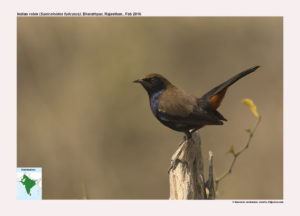Indian Robin

Indian Robin Saxicoloides fulicatus
Etymology:
- Saxicoloides : Latin word saxumrock; alauda
- Fulicatus : Latin word for coot
Vernacular Names: Hindi: Kalchuri, Sans: Kal-pushtadakshinchatka, Pun: Pidda, Ben: Kalchuri, Bhil: Dachko, Guj: Deoli, Kali deva, Devaya kali, Mar: Kaldumnat, Chirak, Kalokhi, Ta: Kari-kuruvi, Kaddukari-kuruvi, Vannati-kuruvi, Te: Nalanchi, Mal: Kalmannati, Kan: Robin, Sinh: Kalu-polkichcha
Distribution in India: Widespread resident in India.
Description: Size of 16 cm, wt. of 17–20 g. The male of nominate race is glossy black above and below, with white shoulder patch and chestnut vent. It has a long black tail typically cocked; black bill and legs. The female is brownish-grey above with browner ear-coverts, dark grey below and has a chestnut vent. The juvenile is like female but darker, throat lightly mottled buff-white. The race cambaiensis male is mid-brown above, female paler than nominate. The race erythrurus is dark brown above.The race intermedius is very dark brown above. The race leucopterus is larger and shorter-tailed, female darker.
Habitat: It is found in palm groves, bare hillsides, open rocky places, newly burnt clearings, arid stony escarpments, low rocky outcrops, and low open scrub with scattered trees, saltpans and sand dunes, stony scrub around human settlements, gardens, graveyards, deserted buildings, villages and dwellings. It is found from lowlands, to 1600 m.
Food habits: It eats Insects like termites, ants, beetles, flies, caterpillars, grasshoppers, bees and wasps and their eggs and spiders. It forages largely on ground, darting about with agile hopping gait and moving from spot to spot in short jerky flight, occasionally entering clumps of herbs or thorn bush, sometimes flipping over small stones and leaves with its bill and it does very little aerial sallying. When it is feeding young, the foraging behaviour includes use of wings and tail in attempts to flush insects.
Breeding habits: They breed in Apr–Jun in Pakistan and India, Mar–Sept in Sri Lanka. It lays two broods. The nest is an untidy, fairly small pad of grass, rootlets and rubbish lined with feathers or hair, often adorned with sloughed snakeskin, placed under stone or clod of earth in ploughed field, in hole in old building, earth bank, tree or stump, in old pot or can, between tangled roots, down well-shaft, in old tomb cavity, under roof tiles or on veranda. The nest-site is often reused for additional broods. They lay a clutch of 2-4 eggs. The incubation period is 11–13 days.